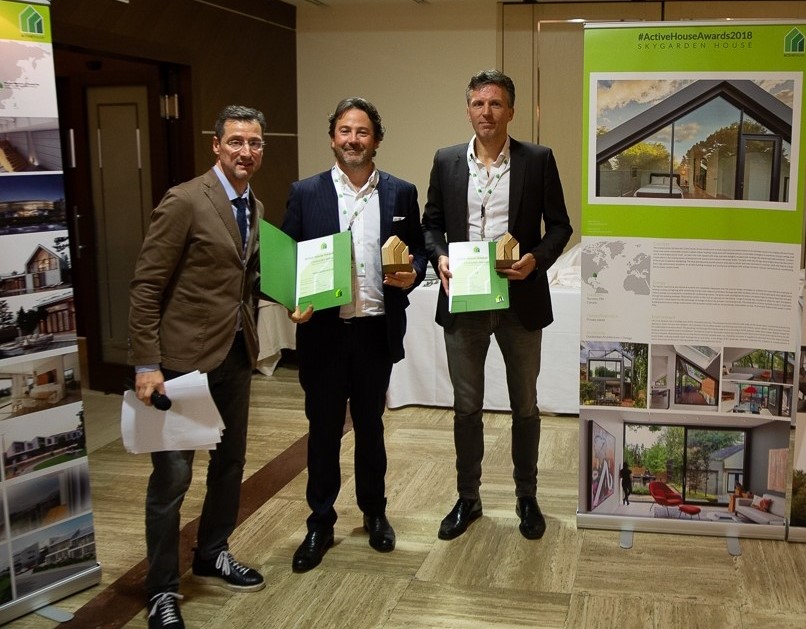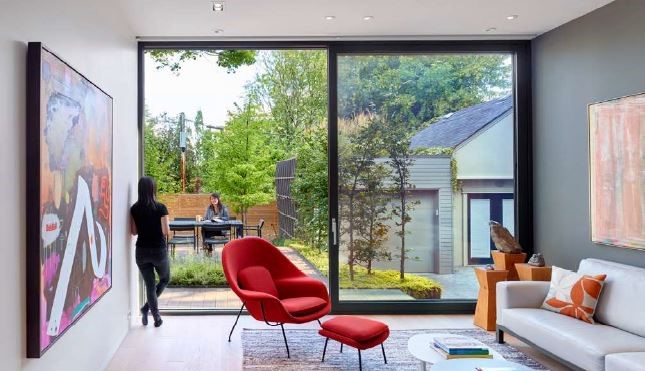Skygarden House: Family home in Active House style

Skygarden House is a one family house in Toronto, Canada designed by Dubbeldam Architecture + Design for a private owner. The project won an Active House Award at the 2018 Active House Symposium. Below Heather Dubbeldam answers a few questions on behalf of the Skygarden House project.
Your project won an award at the Active House Awards this year, congratulations. Why did you submit your project for the Active House Awards?
It can be daunting for the average person to make informed choices regarding sustainable best practices. There is an overwhelming number of factors that need to be taken into consideration – with many of them requiring highly technical knowledge. They can make the process of building sustainably feel out of reach.
To promote a holistic sustainable approach to building design, the public must feel as though it can engage and subscribe to its underlying concepts. An Active House Award provides an assurance that the work being done is to an incredibly high standard relating to comfort, energy and the environment.
Our submission to the Active House Awards is reflective of our practice’s commitment to and interest in advocating for this kind of public engagement and for healthier, more sustainable buildings.
What does winning the Active House Award mean for your project/organisation? What would you say are some of the key features that make Active Houses better buildings?
Having Skygarden House as a recipient of an Active House Award will allow our practice to engage in much broader dialogue with similarly directed professionals and members of industry. As a practice, we strive to create truly liveable and healthy environments. In having this endorsement from the Active House Alliance, we hope to take part in the knowledge-sharing process established by the network, further developing our practice’s sustainable building capabilities.
The Active House Label specifies the proactive measures that must be taken to ensure sustainability and a level of comfort in each certified building. It is this accountability, coupled with its expansive overview that helps to deliver building projects that emphasize long-term solutions as opposed to short-term profit margins.
At this year’s symposium there was a lot of talk about digitalisation and technology changing our buildings. How does your project use these?
Skygarden House’s mechanical and electrical systems are completely integrated with the passive design strategies to achieve the most efficient methods of heating, cooling and lighting while minimizing the cost to do so. For example, the natural ventilation and stack effect through operable windows and the central operable skylights lessen the demand on air-conditioning, which is provided by a high-velocity system that significantly reduces energy use compared to a standard air conditioning system. Using the house’s orientation, large triple-glazed windows are placed strategically to allow for natural light, reducing the need for artificial lighting, and to allow for solar gain in the cold months. In the winter, the tiled flooring over cement base retains the heat from the low sun provided through these large windows at the rear, complementing the in-floor radiant heating system. The green roofs and high-performance insulation help to reduce heat loss and gain through the building envelope. Photovoltaic panels on the roof are planned for the future – rough-in wiring was installed to allow for their later installation as well as for a Tesla battery to take advantage of storage of electricity at lower cost time periods.

How do you think we can convince more people of the importance of healthy buildings? How does your project address this important aspect?
Despite its undeniable benefits, building for sustainability, comfort, and health is still an approach whose merits needs to be communicated to the public. Creating opportunities to promote projects that have successfully incorporated these elements will help introduce the public to how they can be integrated into their lifestyles. Ultimately, it becomes less about convincing them of their importance and instead focuses on showcasing the beneficial ways in which these buildings could positively impact the quality of their lives.
Skygarden House is an example of how buildings can support both the physical and psychological health of their occupants while using its design to appeal to the public. The design of the house incorporates a series of outdoor living spaces on multiple levels to address the owners’ desire for a better connection to the home’s natural surroundings; the owners used to spend their weekends at their country home, located next to a stream and surrounded by trees so they wanted their new home in the city to mimic this bucolic experience in an urban environment. And, although the new house is only 225 m2, it feels much larger—its rooms expand beyond the interior of the house to a series of highly useable outdoor spaces that enrich the domestic experience, each with its own unique character and varying level of privacy. Each of these outdoor spaces is enveloped in natural colour—green in the spring and summer due to plentiful trees and plant material, reds and yellows in the fall, and white and reddish-brown in the winter from the thermally-treated warm-coloured ash decking and wall cladding material.
Active House is all about comfort, energy and environment. How does your project incorporate these aspects?
At a residential scale, Skygarden House explores a broader vision of urbanity that promotes the idea that people do not need more space, just better-designed space. This project reworks an older home while maintaining the existing shell, using design strategies to ‘expand’ the interior space without expanding the footprint of the house and allowing the owners to live in a small footprint.
The house consumes much less energy than equivalent houses of its size, due to all the passive and active sustainable systems employed. Many of these systems also increase the owners’ comfort level, including triple glazing and in-floor radiant heating.

One of this year’s speakers at the symposium suggested that as prices go up, so do the expectations of homebuyers. Do you think the Active House label can help purchasers identify good products?
Yes. Each Active House project serves as a case study for achieving optimal levels of sustainability and comfort. Coupled with the Active House Radar it can become a helpful tool to illustrate how factors affecting energy, environment, and comfort can come together to create optimised living conditions. The Radar can, in turn, references specific products employed in each project, which can give purchasers a visual representation of how their specific needs can be addressed.
If you were to give one piece of advice to next year’s contestants, what would it be?
Every contestant is already producing very sustainable projects, so they should be proud of their accomplishments, even if they don’t win an award. Keep doing what you do and pushing the envelope on sustainability!
You can read more about the Skygarden House project here.


